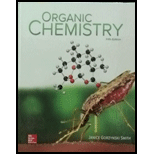
Concept explainers
(a)
Interpretation: All resonance structures for the radical that result from the homolysis of
Concept introduction: The general steps followed by free-radical reaction are stated below:
1. First step is initiation that involves formation of radical.
2. Second step is propagation.
3. Third step is the termination that involves the formation of stable bond.
(b)
Interpretation: An explanation for the given statement that the homolysis of this
Concept introduction: The general steps followed by free-radical reaction are stated below:
1. First step is initiation that involves formation of radical.
2. Second step is propagation.
3. Third step is the termination that involves the formation of stable bond.
Want to see the full answer?
Check out a sample textbook solution
Chapter 15 Solutions
ORGANIC CHEMISTRY-W/ACCESS >CUSTOM<
- Ciprofloxacin is a member of the fluoroquinolone class of antibiotics.(a) Which of its rings are aromatic?arrow_forwardRank the molecules in decreasing (strongest to weakest) acidity. Include ALL resonance structures with arrows and explain reasoning for rank.arrow_forwardDraw the curved arrow(s) to depict the formation of the keto form of an enolate ion via a strong base, B. Complete the resonance structures of the enolate anion\'s keto and enolate forms with bonds, charges, and nonbonding electron pairs. Use curved arrows to show how the keto form resonates to the enolate form.arrow_forward
- Identify the pericyclic reactions in the following reaction schemes. Give the complete reaction name and indicate the course of the reaction with the aid of the arrow notation.arrow_forwardName the PRODUCT compound and give it's molecular weight Q. Which is a better nucleophile methoxide or methanol? Suggest a reason why?arrow_forwardWhat carbon radical is formed by homolysis of the C–Hb bond inpropylbenzene? Draw all reasonable resonance structures for thisradical.arrow_forward
- Fluorination of a benzene ring can be accomplished with Selectfluor, a reagent that contains a fluorine bonded to a positively charged nitrogen atom. Fluorination is a useful reaction because several common drugs, such as the cholesterol-lowering drug atorvastatin, contain a fluorine bonded to an aromatic ring. Assuming that fluorination is analogous to other examples of electrophilic aromatic substitution, draw a stepwise mechanism for the following reaction.arrow_forwardcis-4-Bromocyclohexanol and trans-4-bromocyclohexanol form the same elimination product but a different substitution product when they react with HO-. a. Why do they form the same elimination product? b. Explain, by showing the mechanisms, why different substitution products are obtained. c. How many stereoisomers does each of the elimination and substitution reactions form?arrow_forwardA. Arrange the following radicals in order of decreasing rate of bromination. Justify your answer. B. Trehalose and isomaltose are both dimers of glucose. However, they have considerablydifferent reactivities. Concisely explain why these differences are observed. -Isomaltose is a reducing sugar while trehalose is not.-Trehalose is very resistant to acid hydrolysis while isomaltose can be acid-hydrolyzed withease.arrow_forward
- What is the major alkene formed when A is treated with POCl3 andpyridine? Explain why the major product is different in these reactions.arrow_forwardThe question is: "Draw the curved arrow mechanism for the reaction between pentan-2-one and (CH3)3O– in t-butanol to form an enolate. Draw all electrons and charges on both resonance structures. Then answer the question about the reaction." I got the initial arrows correct, but am not entirely sure what the carbanion intermediate would look like and then what the curved arrows would be to convert it to its final oxanion formarrow_forwardExplain why electrophilic aromatic substitution in Pyrrole takes place at C-2 positions whereas, in Pyridine it takes place at C-3 position. Write the role of Corticosteroids in Pharmaceutical field. Write the rich source of Vitamin D. Write the metabolic pathway of Vitamin D to its most active form and which are the organ involved.arrow_forward
